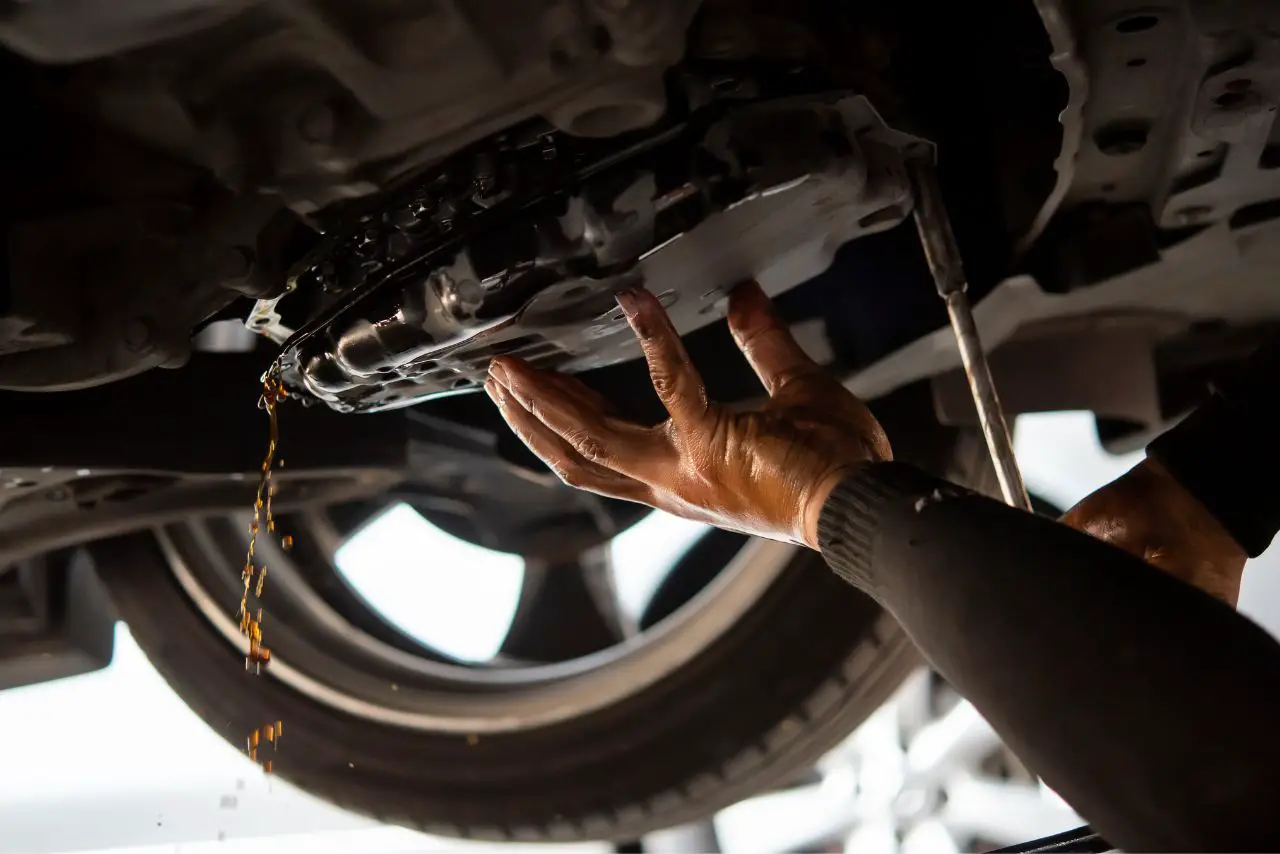If you’re driving your car and suddenly feel it slipping out of gear, it’s important to check your transmission fluid level right away.
Low levels could be a sign that there is an issue with the transmission system, and if left unchecked can lead to costly repairs down the road.
Knowing how far you can drive on low transmission fluid will help you decide whether it is safe for you to press on or take alternate measures. Read on to find out How Far Can I Drive On Low Transmission Fluid!
If your vehicle has low transmission fluid, it is recommended that you drive no more than 10-15 miles before having the problem corrected. Driving too far on low transmission fluid can cause damage to components within the system which can lead to costly repairs and potentially future breakdowns.
Table of contents
Is it OK to drive with low transmission fluid?
Generally speaking, it is not recommended to drive your car when the transmission fluid is low. The reason for this is that a vehicle’s transmission relies on the proper level of lubrication in order to work properly and prevent damage from occurring.
Without enough fluid, the gears can grind against each other or become stuck together, causing major problems.
In addition, driving with too little transmission fluid can cause serious wear and tear on various components like seals and gaskets within the system.
This could lead to costly repairs that would have otherwise been avoidable if you topped off your fluids regularly as part of basic maintenance.
It should also be noted that driving with low levels of transmission fluid can significantly reduce fuel efficiency since some models use pressurized oil to help cool down parts during operation.
As such, you may end up spending more at the pump over time due to decreased MPG ratings when operating under these conditions.
Signs and Symptoms of Low Transmission Fluid:
Low transmission fluid can indicate a variety of issues with your vehicle, and it’s important to be aware of the signs and symptoms.
These various signs should not be ignored; if you experience any of them it’s important to check your vehicle’s transmission level immediately and take necessary action steps from there.
What if I Run out Of Transmission Fluid?
If you run out of transmission fluid, it can pose a serious threat to your vehicle. Without the proper lubrication, metal parts in the transmission will grind against each other and cause major damage.
In addition, running without transmission fluid may overheat the components and lead to complete failure. Furthermore, air pockets created by lack of fluid can cause shifting issues or erratic performance in some vehicles.
It’s best to have your mechanic check for signs of low transmission fluid if you notice any changes with how your car is driving or operating.
When topping off your vehicle’s fluids, keep an eye on it regularly so that you don’t get caught without enough before it’s too late.
If you do find yourself running out of transmission fluid unexpectedly while on the road, try to pull over as soon as possible and contact a tow truck service for assistance getting back home safely and securely.
Effects of Driving with Low Transmission Fluids:

Driving with low transmission fluids can have serious effects. It places an unnecessary amount of strain on the entire system, making it more difficult for the automatic transmission to shift gears.
Overall, driving with low transmission fluids is never recommended unless absolutely necessary as doing so jeopardizes both safety and performance capabilities while simultaneously increasing the potential risks associated with avoiding regular maintenance checks.
Potential Causes for Low Levels of Transmission Fluid:
Low levels of transmission fluid can be caused by a number of different issues.
If any problems arise it is important for drivers seek out professional automotive help right away in order diagnose and repair any possible causes before further damage occurs.
When You Should Refill your Vehicle’s Transmission Fluid?
If your vehicle is low on transmission fluid, it’s important to refill it as soon as possible.
Refilling the transmission fluid will ensure that your car has enough lubrication for its internal components and provide optimal performance while you’re driving.
Additionally, replacing the fluid can help to prevent any major issues or costly repairs in the future.
In general, you should check your transmission fluid level every two months or so and be sure to top off the levels if they are getting low.
If a lot of time has passed since you last checked (or topped off) your fluids, then it’s best to replace all of them with new ones.
The exact frequency of changing out old transmission fluid varies between vehicles, but generally speaking manufacturers recommend doing so every 30-60 thousand miles depending on how often and where you drive most frequently.
Finally, always make sure that whatever type of transmission fluid you use matches what is specified in your owner’s manual – using anything else could potentially cause serious damage to your engine’s moving parts over time!
Preventing Low Levels Of Transmission Fluids:

Transmission fluid is essential for cars to function properly and safely. To ensure the proper operation of your transmission, it is important to keep an eye on the levels of this vital liquid as low levels can cause serious damage.
Below are some tips for preventing transmission fluids from running low:
Regular Maintenance Checks:
Firstly, regular maintenance checks should be done to ensure that all components related to the transmission system are in good condition and performing optimally.
This will help identify any potential problems before they become too severe and lead to a drop in the level of transmission fluid.
It’s also wise to check the fluid level regularly by looking at its dipstick or consulting a mechanic if necessary.
Use only High-Quality Products:
Secondly, when topping off with more oil or changing out old oil completely, use only high-quality products specified by your car manufacturer – otherwise you risk damaging other parts such as seals or filters that could further reduce your car’s capacity for efficient performance over time.
Not to Overfill Past Full Capacity:
Additionally, make sure not to overfill past full capacity – excess heat buildup due to excessive amounts of lubricant can have adverse effects on engine efficiency and longevity.
Replace Filter Elements:
Finally, replace filter elements whenever servicing takes place; worn filters impede flow and trap contaminants leading up clogged passages which results in reduced pressure within affected systems leading up ultimately causing starvation throughout various portions of said systems.
Thus resulting lowered capacities overall including lower operational temperatures etcetera!
How Low Is Too Low for Transmission Fluid?
When it comes to transmission fluid, there is a definite “too low” threshold. When the fluid in your car’s transmission drops too low, it can put an immense strain on the system and result in costly repairs or even total failure of the system.
Transmission fluid lubricates moving parts and keeps them running smoothly, allowing for smooth gear shifts and improved fuel efficiency.
Without enough fluid present these components are more likely to wear out quickly or become damaged from friction.
To avoid any potential issues with your transmissions reliability, you should always keep at least the manufacturer-recommended level of transmission fluid in your vehicle.
Different vehicles have different amounts that they require for optimal performance; make sure you regularly check the dipstick and top up if necessary to ensure that you never run too low on vital fluids.
If you notice a sudden decrease in levels over time without topping up then this may indicate a leak somewhere which needs attention as soon as possible to prevent further damage occurring down the line.
Finally if you do find yourself running especially low on transmission fluid then don’t be tempted to drive until its replenished.
Doing so could cause serious damage not only to your cars engine but potentially blockages within other mechanical systems also depending on how much lower than expected levels drop below normal operating range is reached.
Can You Start an Engine without Transmission Fluid?
It is possible to start an engine without transmission fluid, but it should not be done. The transmission plays an essential role in the operation of a vehicle, providing power from the engine to the drivetrain and allowing smooth shifts between gears.
Without sufficient transmission fluid, these functions are impaired and can lead to serious damage.
Without adequate lubrication for its internal parts, friction will increase dramatically inside the transmission which can ultimately result in costly repairs or even total failure.
Additionally, if there is insufficient pressure within the system due to low fluid levels then shifting may become difficult or impossible as no power will be delivered through the driveline when operating without any fluid at all.
Ultimately, attempting to start an engine with no transmission fluid could potentially cause severe damage that would cost far more than simply topping up your existing supply – especially considering how relatively inexpensive it usually is?
To keep your car running reliably and safely for many miles ahead you should always ensure you have enough transmission fluid before starting your journey.
- 10 Best Gear Oil for Limited Slip Differentials (Reviewed!)
- Allison 1000 Transmission Fluid Type (5 Best Options!)
- 91 Octane Vs 93 Which One You Use? (The Surprising Truth!)
- Oil Pressure Gauge Not Working: (Guaranteed Fix!)
- 10 Best Transmission Fluid for 4l60e (Tested by Experts!)
- 10 Best Ceramic Coating For Wheels (Used By Real Users!)












Leave a Reply